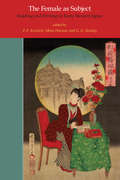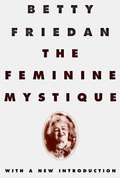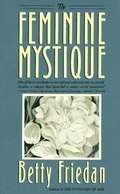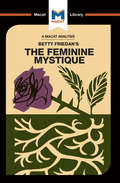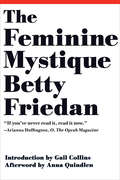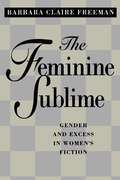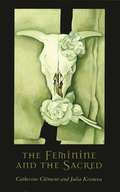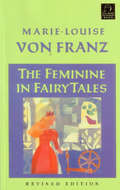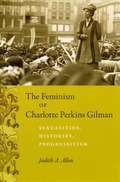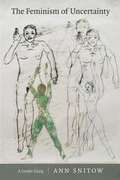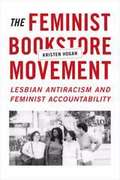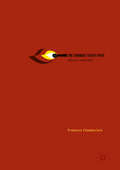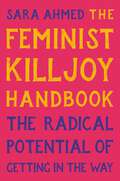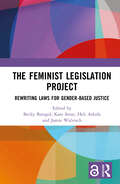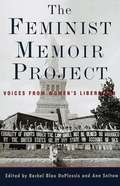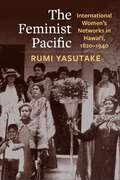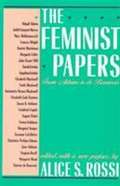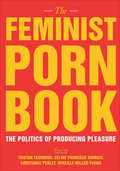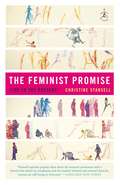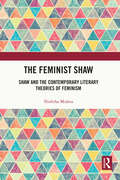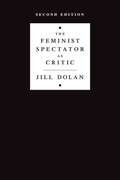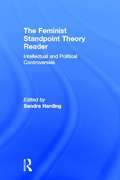- Table View
- List View
The Female Voice in Sufi Ritual: Devotional Practices of Pakistan and India
by Abbas Shemeem BurneyThe female voice plays a more central role in Sufi ritual, especially in the singing of devotional poetry, than in almost any other area of Muslim culture. This research clarifies why the female voice is so important in Sufi practice and underscores the many contributions of women to Sufism and its rituals.
The Female as Subject: Reading and Writing in Early Modern Japan
by G. Rowley Mara Patessio P. F. KornickiMichigan Monograph Series in Japanese Studies No. 70 The Female as Subject reveals the rich and lively world of literate women in Japan from 1600 through the early twentieth century. Eleven essays by an international group of scholars from Europe, Japan, and North America examine what women of different social classes read, what books were produced specifically for women, and the genres in which women themselves chose to write. The authors explore the different types of education women obtained and the levels of literacy they achieved, and they uncover women's participation in the production of books, magazines, and speeches. The resulting depiction of women as readers and writers is also enhanced by thirty black-and-white illustrations. For too long, women have been largely absent from accounts of cultural production in early modern Japan. By foregrounding women, the essays in this book enable us to rethink what we know about Japanese society during these centuries. The result is a new history of women as readers, writers, and culturally active agents. The Female as Subject is essential reading for all students and teachers of Japan during the Edo and Meiji periods. It also provides valuable comparative data for scholars of the history of literacy and the book in East Asia.
The Feminine Mystique
by Anna Quindlen Betty FriedanThe book that changed the consciousness of a country -- and the world. "The Feminine Mystique", is the book that defined "the problem that has no name", and that launched the Second Wave of the feminist movement, and has been awakening women and men with its insights into social relations, which still remain fresh, ever since.
The Feminine Mystique
by Betty FriedanFirst published in 1963, "The Feminine Mystique" ignited a revolution that profoundly changed our culture, our consciousness, and our lives. Today it newly penetrates to the heart of issues determining our lives -- and sounds a call to arms against the very real dangers of a new feminine mystique in the economic and political turbulence of the 1990s. Three decades later, the underlying issues raised by Betty Friedan strike at the core of the problems women still face at home and in the marketplace. As women continue to struggle for equality, to keep their hard-won gains, to find fulfillment in their careers, marriage and family, "The Feminine Mystique" remains the seminal consciousness-raising work of our times.
The Feminine Mystique
by Elizabeth WhitakerBetty Friedan's book The Feminine Mystique is possibly the best-selling of all the titles analysed in the Macat library, and arguably one of the most important. Yet it was the product of an apparently minor, meaningless assignment. Undertaking to approach former classmates who had attended Smith College with her, 10 years after their graduation, the high-achieving Friedan was astonished to discover that the survey she had undertaken for a magazine feature revealed a high proportion of her contemporaries were suffering from a malaise she had thought was unique to her: profound dissatisfaction at the ‘ideal’ lives they had been living as wives, mothers and homemakers. For Friedan, this discovery stimulated a remarkable burst of creative thinking, as she began to connect the elements of her own life together in new ways. The popular idea that men and women were equal, but different – that men found their greatest fulfilment through work, while women were most fulfilled in the home – stood revealed as a fallacy, and the depression and even despair she and so many other women felt as a result was recast not as a failure to adapt to a role that was the truest expression of femininity, but as the natural product of undertaking repetitive, unfulfilling and unremunerated labor. Friedan's seminal expression of these new ideas redefined an issue central to many women's lives so successfully that it fuelled a movement – the ‘second wave’ feminism of the 1960s and 1970s that fundamentally challenged the legal and social framework underpinning an entire society.
The Feminine Mystique (50th Anniversary Edition)
by Anna Quindlen Betty Friedan Gail Collins"If you've never read it, read it now."--Arianna Huffington, O, The Oprah Magazine <P><P> Landmark, groundbreaking, classic--these adjectives barely do justice to the pioneering vision and lasting impact of The Feminine Mystique. Published in 1963, it gave a pitch-perfect description of "the problem that has no name": the insidious beliefs and institutions that undermined women's confidence in their intellectual capabilities and kept them in the home. Writing in a time when the average woman first married in her teens and 60 percent of women students dropped out of college to marry, Betty Friedan captured the frustrations and thwarted ambitions of a generation and showed women how they could reclaim their lives. <P><P> Part social chronicle, part manifesto, The Feminine Mystique is filled with fascinating anecdotes and interviews as well as insights that continue to inspire. This 50th-anniversary edition features an afterword by best-selling author Anna Quindlen as well as a new introduction by Gail Collins.
The Feminine Sublime: Gender and Excess in Women's Fiction
by Barbara Claire FreemanThe Feminine Sublime provides a new and startling insight into the modes and devices employed in the creation of women's fiction since the eighteenth century. Barbara Claire Freeman argues that traditional theorizations of the sublime depend upon unexamined assumptions about femininity and sexual difference, and that the sublime could not exist without misogynistic constructions of "the feminine." Taking this as her starting point, Freeman suggests that the "other sublime" that comes into view from this new perspective not only offers a crucial way to approach representations of excess in women's fiction, but allows us to envision other modes of writing the sublime.Freeman reconsiders Longinus, Burke, Kant, Weiskel, Hertz, and Derrida while also engaging a wide range of women's fiction, including novels by Chopin, Morrison, Rhys, Shelley, and Wharton. Addressing the coincident rise of the novel and concept of the sublime in eighteenth-century European culture, Freeman allies the articulation of sublime experience with questions of agency and passion in modern and contemporary women's fiction. Arguments that have seemed merely to explain the sublime also functioned to evaluate, domesticate, and ultimately exclude an otherness that is almost always gendered as feminine. Freeman explores the ways in which fiction by American and British women, mainly of the twentieth century, responds to and redefines what the tradition has called "the sublime."
The Feminine and the Sacred
by Jane Marie Todd Clément Catherine Julia KristevaIn November 1996, Catherine Clément and Julia Kristeva began a correspondence exploring the subject of the sacred. Their correspondence lead them to a controversial and fundamental question: is there anything sacred that can at the same time be considered strictly feminine?
The Feminine and the Sacred (European Perspectives: A Series in Social Thought and Cultural Criticism)
by Julia Kristeva Catherine ClémentIn November 1996, Catherine Clément and Julia Kristeva began a correspondence exploring the subject of the sacred. In this collection of those letters Catherine Clément approaches the topic from an anthropologist's point of view while Julia Kristeva responds from a psychoanalytic perspective. Their correspondence leads them to a controversial and fundamental question: is there anything sacred that can at the same time be considered strictly feminine?The two voices of the book work in tandem, fleshing out ideas and blending together into a melody of experience. The result is a dialogue that delves into the mysteries of belief -- the relationship between faith and sexuality, the body and the senses -- which, Clément and Kristeva argue, women feel with special intensity.Although their discourse is not necessarily about theology, the authors consider the role of women and femininity in the religions of the world, from Christianity and Judaism to Confucianism and African animism. They are the first to admit that what they have undertaken is "as impossible to accomplish as it is fascinating." Nevertheless, their wide-ranging and exhilarating dialogue succeeds in raising questions that are perhaps more important to ask than to answer.
The Feminine in Fairy Tales: Revised Edition
by Marie-Louise von FranzIn this engaging commentary, the distinguished analyst and author Marie-Louise von Franz shows how the Feminine reveals itself in fairy tales of German, Russian, Scandinavian, and Eskimo origin, including familiar stories such as "Sleeping Beauty," "Snow White and Rose Red," and "Rumpelstiltskin." Some tales, she points out, offer insights into the psychology of women, while others reflect the problems and characteristics of the anima, the inner femininity of men. Dr. von Franz discusses the archetypes and symbolic themes that appear in fairy tales as well as dreams and fantasies, draws practical advice from the tales, and demonstrates its application in case studies from her analytical practice.
The Feminism of Charlotte Perkins Gilman: Sexualities, Histories, Progressivism
by Judith A. AllenJudith Allen provides the first comprehensive assessment of Gilman's complicated feminism by exploring the renowned writer's theories of sexuality and evolutionary analyses of androcentric or male-dominated culture.
The Feminism of Uncertainty: A Gender Diary
by Ann SnitowThe Feminism of Uncertainty brings together Ann Snitow's passionate, provocative dispatches from forty years on the front lines of feminist activism and thought. In such celebrated pieces as "A Gender Diary"--which confronts feminism's need to embrace, while dismantling, the category of "woman"--Snitow is a virtuoso of paradox. Freely mixing genres in vibrant prose, she considers Angela Carter, Doris Lessing, and Dorothy Dinnerstein and offers self-reflexive accounts of her own organizing, writing, and teaching. Her pieces on international activism, sexuality, motherhood, and the waywardness of political memory all engage feminism's impossible contradictions--and its utopian hopes.
The Feminist Bookstore Movement: Lesbian Antiracism and Feminist Accountability
by Kristen HoganFrom the 1970s through the 1990s more than one hundred feminist bookstores built a transnational network that helped shape some of feminism's most complex conversations. Kristen Hogan traces the feminist bookstore movement's rise and eventual fall, restoring its radical work to public feminist memory. The bookwomen at the heart of this story--mostly lesbians and including women of color--measured their success not by profit, but by developing theories and practices of lesbian antiracism and feminist accountability. At bookstores like BookWoman in Austin, the Toronto Women's Bookstore, and Old Wives' Tales in San Francisco, and in the essential Feminist Bookstore News, bookwomen changed people's lives and the world. In retelling their stories, Hogan not only shares the movement's tools with contemporary queer antiracist feminist activists and theorists, she gives us a vocabulary, strategy, and legacy for thinking through today's feminisms.
The Feminist Fourth Wave
by Prudence ChamberlainThis book examines the fourth wave of feminism within the United Kingdom. Focusing on examples of contemporary activism it considers the importance of understanding affect and temporality in relation to surges of feminist activity. Examining the wave's historical use in the feminist movement, the book redefines the symbol in an attempt to overcome difficulties of generations, identities and divisions. The author contends that feminism must develop its own methods for time keeping, in which past activism and future aspirations touch on the present moment. Through this unique temporality, she continues, feminism can make space for affective ties to create intense moments of activism, in which surges of feeling catalyse and sustain mass action. This thought-provoking book, with its exploration of the relationship between feeling, the personal and political, will appeal to students and academics working in the fields of gender studies, feminism and affect studies.
The Feminist Killjoy Handbook: The Radical Potential of Getting in the Way
by Sara AhmedA renowned feminist thinker argues we need to get in the way of happiness, our own and other people&’s, to build a more just world Do you refuse to laugh at offensive jokes? Have you ever been accused of ruining dinner by pointing out your companion&’s sexist comment? Are you often told to stop being so &“woke&”? If so, you might be a feminist killjoy—and this handbook is for you. In this book, feminist theorist Sara Ahmed shows how killing joy can be a radical world-making project. Presenting sharp analysis of literature, film, and influential feminist works, and drawing on her own experiences as a queer feminist scholar-activist of color, Ahmed reveals the invaluable lessons of the feminist killjoy, from the importance of asking questions to the power of the eye roll. The Feminist Killjoy Handbook offers an outstretched hand to feminist killjoys everywhere and an essential intellectual guide to the transformative power of getting in the way.
The Feminist Legislation Project: Rewriting Laws for Gender-Based Justice
by Heli Askola Kate Seear Jamie Walvisch Becky BatagolIn this book, leading law academics along with lawyers, activists and others demonstrate what legislation could look like if its concern was to create justice for women.Each chapter contains a short piece of legislation – proposed in order to address a contemporary legal problem from a feminist perspective. These range across criminal law (sexual offences, Indigenous women’s experiences of criminal law, laws in relation to forced marriage, modern slavery, childcare and sentencing), civil law (aged care and housing rights, regulating the gig economy; surrogacy, gender equity in the construction industry) and constitutional law (human rights legislation, reimagining parliaments where laws are made for the benefit of women). The proposed laws are, moreover, drafted with feedback from a senior parliamentary draftsperson (providing guidance to contributors in a personal capacity), to ensure conformity with legislative rigour, as well as accompanied by an explanation of their reasons and their aims. Although the legislation is Australian-based, the issues raised by each are recognisably global, and are reflected in the legislation of most other nations.This first feminist legislation project will appeal to scholars of feminist legal studies, gender and the law, gender studies and others studying or working in relevant legal areas.
The Feminist Memoir Project: Voices from Women's Liberation
by Ann Snitow Rachel Blau DuplessisThe women of The Feminist Memoir Project give voice to the spirit, the drive, and the claims of the Women's Liberation Movement they helped shape, beginning in the late 1960s. These 32 writers were among the thousands to jump-start feminism in our time. Here, in pieces that are passionate, personal, critical, and witty, they describe what it felt like to make history, to live through and contribute to the massive social movement that transformed the nation. What made these particular women rebel? And what experiences, ideas, feelings, and beliefs shaped their rebellion? How did they maintain the will and energy to keep such an unwomanly struggle going for so long, and continuing still? Memoirs and responses by Kate Millett, Vivian Gornick, Michele Wallace, Alix Kates Shulman, Joan Nestle, Jo Freeman, Yvonne Rainer, Barbara Smith, Ellen Willis, and many more embody the excitement that fueled the movement and the conflicts that threatened it from within. These stories tell how the world we live in changed. With The Feminist Memoir Project, these activists contribute to yet another movement project, the political work of memory.
The Feminist Pacific: International Women's Networks in Hawai'i, 1820–1940 (Global America)
by Rumi YasutakeAs competing American, European, and later Japanese imperial and colonial ambitions spread across the ocean in the nineteenth century, Honolulu emerged as a transnational hub for the exchange of ideas. Rumi Yasutake reveals the pivotal role of women’s organizing in this era of rapid globalization, tracing how diverse movements intersected and converged in Hawai‘i—with worldwide consequences.The Feminist Pacific examines transnational networks in Hawai‘i beginning in 1820, with the arrival of American missionary wives, and through the rise of women’s internationalism in the interwar years. It follows an array of suffragists, missionaries, maternalists, and antiwar activists in their international campaigns for peace and social justice that culminated in the formation of the Pan-Pacific Women’s Association (PPWA) and subsequent conferences. Yasutake explores how these movements radiated from Honolulu and branched out to the United States, Japan, and China. She illuminates their contradictions, showing how women’s striving for collective power went at once in the face of and hand in hand with globalization, settler colonialism, and imperialism. Yasutake underscores how the PPWA and the movements that formed it wrestled with the dichotomies of their world: home and public, domestic and foreign, native and settler, white and nonwhite, feminist and antifeminist. Bridging nineteenth-century Protestant churchwomen’s evangelism with twentieth-century feminist internationalism, this book recasts women’s global organizing from the perspective of the Pacific.
The Feminist Papers: From Adams to De Beauvoir
by Alice S. RossiHere are, as Alice Rossi claims in her well-written preface, 'the essential works of feminism, ' published over a period of 200 years. Her introductions to each section are informative and written with nonpolemical grace. -- Doris Grumbach, New Republic
The Feminist Porn Book: The Politics of Producing Pleasure
by Tristan Taormino, Celine Parreñas Shimizu, Constance Penley and Mireille Miller-Young&“This thrilling anthology brings together scholars, producers, and fans of feminist pornography to define an emerging movement of gender and sexual visionaries.&” —Lisa Duggan The Feminist Porn Book brings together for the first time writings by feminists in the adult industry and research by feminist porn scholars. This book investigates not only how feminists understand pornography, but also how feminists do porn—that is, direct, act in, produce, and consume one of the world&’s most lucrative and growing industries. With original contributions by Susie Bright, Candida Royalle, Betty Dodson, Nina Hartley, Buck Angel, Lynn Comella, Jane Ward, Ariane Cruz, Kevin Heffernan, and more, The Feminist Porn Book updates the arguments of the porn wars of the 1980s, which sharply divided the women&’s movement, and identifies pornography as a form of expression and labor in which women and racial and sexual minorities produce power and pleasure. &“Besides being extremely thought-provoking, this must-read collection is accessible to all readers, and the topic inherently makes it engaging and fun.&” —Publishers Weekly, starred review
The Feminist Promise: 1792 to the Present
by Christine StansellIn this definitive volume, respected historian Christine Stansell tells the story of one of the great democratic movements of our times. She paints richly detailed portraits of well-known leaders--Mary Wollstonecraft, Elizabeth Cady Stanton, Betty Friedan--but others, too, appear in a new light, including Ruth Bader Ginsburg and Toni Morrison. Accounting for the failures of feminism as well as the successes, Stansell notes the emergence in the early 1900s of the dashing "New Woman"; the passing of the Nineteenth Amendment, which granted women the right to vote; the post-World War II collapse of suburban neo-Victorianism; the radical feminism of the 1960s; and the fight for women's rights in developing countries in the era of international feminist movements. <P><P> A soaring work, The Feminist Promise is bound to become an authoritative source on this essential subject for decades to come, for the failures of feminism as well as the successes. She notes significant moments in the struggle for gender equality, such as the emergence in the early 1900s of the dashing "New Woman"; the passing of the Nineteenth Amendment, which granted women the right to vote; the post-World War II collapse of suburban neo-Victorianism; and the radical feminism of the 1960s--all of which led to vast changes in American culture and society. The Feminist Promise dramatically updates our understanding of feminism, taking the story through the age of Reagan and into the era of international feminist movements that have swept the globe. Stansell provocatively insists that the fight for women's rights in developing countries "cannot be separated from democracy's survival." <P><P>A soaring work unprecedented in scope, historical depth, and literary appeal, The Feminist Promise is bound to become an authoritative source on this essential subject for decades to come on. At once a work of scholarship, political observation, and personal reflection, it is a book that speaks to the demands and challenges--individual, national, and international--of the twenty-first century.
The Feminist Shaw: Shaw and the Contemporary Literary Theories of Feminism
by Nishtha MishraThis book takes us through the life and works of George Bernard Shaw as a feminist. It critically explores his major plays to showcase how his works discuss ideas, practices, discourses, and ideologies that are considered to be antecedents to the modern feminist movements. While involvement of male feminists in feminist movements prior to the twentieth century were sporadic, isolated, and relatively unconnected, Shaw used the dramatic form of realistic theatre to communicate socialist and feminist ideas to his contemporary audience. The volume sheds light on how Shaw in his plays and prefaces exposes the iniquities suffered by women. His women characters do not conform to the Victorian notions of femininity; voice self-awareness, self-evaluation, and realisation of personal worth; and break free from the typical mythical representation in literature, to pave the way for the future generations of female character. Shaw’s women break the stereotypes of Victorian society to voice and follow their dreams and desires without the fear of societal sanction. Through selections from texts such as Back to Methuselah, Pygmalion, Candida, Arms and the Man, St. Joan, Mrs. Warren’s Profession, Man and Superman, The Black Girl in her search of God, and The Simpleton of Unexpected Isles, this book highlights how Shaw gave the world ideologies that have since been adapted by the second and third wave feminists. Foregrounding Shaw’s critical role in strengthening feminist characters in modern literature, this volume will be of great interest to scholars and researchers of literature and literary criticism, theatre studies, feminism, and gender studies.
The Feminist Spectator as Critic (Second Edition)
by Jill DolanThe Feminist Spectator as Critic broke new ground as one of the pioneering books on feminist spectatorship, encouraging resistant readings to generate feminist meanings in performance. Approaching live spectatorship through a range of interdisciplinary methods, the book has been foundational in theater studies, performance studies, and gender/sexuality/women's studies. This updated and enlarged second edition celebrates the book's twenty-fifth anniversary with a substantial new introduction and up-to-the-moment bibliography, detailing the progress to date in gender equity in theater and the arts, and suggesting how far we have yet to go.
The Feminist Standpoint Revisited, And Other Essays
by Nancy C.M. HartsockIn this book, Nancy C. M. Hartsock offers her current thinking about the development of feminist political economy, focusing on the relationships between feminist theory and activism, feminism and Marxism, and postmodernism and feminist politics.
The Feminist Standpoint Theory Reader: Intellectual and Political Controversies
by Sandra Hardingcompliation of essays covering various aspects of standpoint theory

